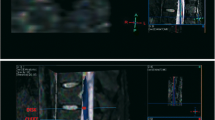Summary
The transplantation of human brain tumors in the brain of the golden hamster regularly resulted in foreign-body reactions as a chronic, proliferative, inflammation in the leptomeningeal connective tissue. In the brain tissue itself, however, such inflammatory phenomena developed seldomly and only weakly. No continuous heterologous growth could be found in any of the 23 tumors transplanted intracerebrally. In only five cases (3 glioblastomas, 1 oligodendroglioma, and 1 amelanotic melanoma) could tumor cell proliferation be documented in the cerebral ventricles during the first days after implantation.
In agreement with the findings of Murphy and Sturm (1923), and Greene (1951, 1953), the success of such transplantations depends mainly on whether the xenogeneic tumor cells come to rest in the brain tissue proper or in a cerebrospinal fluid-containing space, since the mesenchymal foreign-body reaction of the latter localization is certainly the more pronounced of the two. On the other hand, it is proposed that the cerebrospinal fluid is a more suitable milieu for tumor proliferation than brain tissue.
Zusammenfassung
Transplantationen menschlicher Hirntumoren in Goldhamstergehirne führten in diesen regelmäßig zu Abwehrreaktionen in Form einer chronisch-proliferativen Entzündung im leptomeningealen Bindegewebe. Im Hirngewebe waren derartige proliferative Entzündungserscheinungen inkonstant und in der Regel nur gering entwickelt. Bei keinem der 23 transplantierten Tumoren konnte ein dauerndes Wachstum beobachtet werden. Lediglich bei 5 Transplantattumoren (3 Glioblastome, 1 Oligodendrogliom und 1 amelanotisches Melanoblastom) fanden sich in den ersten Tagen nach der Transplantation Tumorzellproliferate im Bereich der Hirnkammern. In Übereinstimmung mit Murhpy u. Sturm (1923) sowie Greene (1951, 1953) wird angenommen, daß Angehen und Wachstum der Transplantate wesentlich davon abhängig ist, ob diese im Hirngewebe oder im Liquor angesiedelt werden, da sich im Hirngewebe mesenchymale Abwehrreaktionen nur in geringerem Grade zu entwickeln vermögen als im Liquor. Andererseits wird es jedoch für wahrscheinlich gehalten, daß der Liquor sich primär besser als Wachstumsmilieu eignet als das Hirngewebe.
Similar content being viewed by others
Literatur
Chestermann, F. C.: Intracranial heterotranplantation of human tumours. Brit. J. Cancer 9, 51 (1955).
Goldenberg, D. M.: Die Verwendung einiger neuer Human-Tumorstämme in der experimentellen Krebsforschung. Arch. Geschwulstforsch. 29, 1 (1967).
, H. Schmidt u. S. Witte: Tierexperimentelle Beobachtungen über das intracerebrale Wachstum menschlicher Tumoren. Z. Krebsforsch. 69, 316 (1967).
Greene, H. S. N.: The transplantation of human brain tumors to the brains of laboratory animals. Cancer Res. 13, 422 (1953).
: The transplantation of tumors to the brains of heterologous species. Cancer Res. 11, 529 (1951).
Janisch, W.: Heterotransplantation of human brain tumours with untreated albino rats of different age-groups. Acta Un. Int. Cancr. 20, 1590 (1964).
Medawar, P. B.: Immunity to homologous grafted skin. III. The fate of skin homografts transplanted to the brain, to subcutaneous tissue, and to the anterior chamber of the eye. Brit. J. exp. Path. 29, 5 (1949).
Murphy, J. B., and E. Sturm: Conditions determining the transplantability of tissue in the brain. J. exp. Med. 38, 183 (1923).
Rambo, O. N. jr., R. Fuson, M. Hattori, and E. J. Eichwald: Immune phenomena elicited by transplanted tumors. I. The participation of the eye and the brain. Cancer Res. 14, 169 (1954).
Scotti, T. M., M. A. Wryk, M. Dorsey jr., and M. M. Sigel: Transplantation of human malignant epithelial cells from tissue culture to rat brains. Cancer Res. 20, 58 (1960).
Shirai, Y.: On the transplantation of the rat sarcoma in adult heterogeneous animals. Jap. med. World 1, 14 (1921).
Scheinberg, L. C., F. L. Edelmann, and W. A. Levy: Is the brain “an immunologically privileged site”? Arch. Neurol. (Chic.) 11, 248 (1964).
Schmidt, H.: Wachstum und Ausbreitung intracerebral transplantierter Geschwülste. Verh. dtsch. Ges. Path. 51, 356 (1967).
Wilson, C. B., and M. Barker: Cerebrospinal fluid as a culture medium for human brain tumors. Neurology 16, 1064 (1966).
Author information
Authors and Affiliations
Additional information
D 29.
Rights and permissions
About this article
Cite this article
Schmidt, H., Kleinecke, G. & Goldenberg, D.M. Über mesenchymale Abwehrreaktionen in Goldhamstergehirnen nach Transplantation menschlicher Gehirntumoren. Z Krebs-forsch 71, 308–315 (1968). https://doi.org/10.1007/BF00524412
Received:
Issue Date:
DOI: https://doi.org/10.1007/BF00524412




